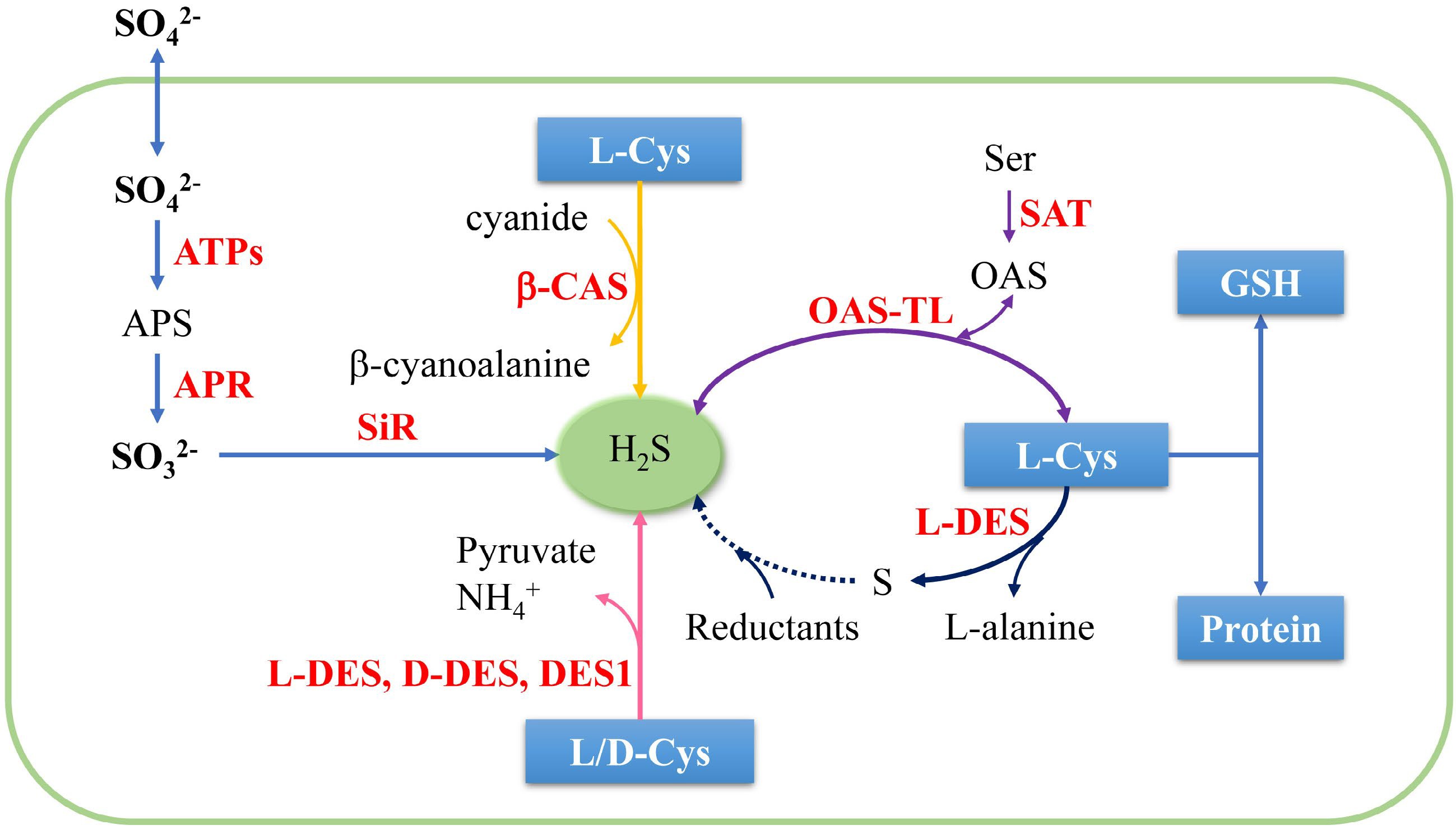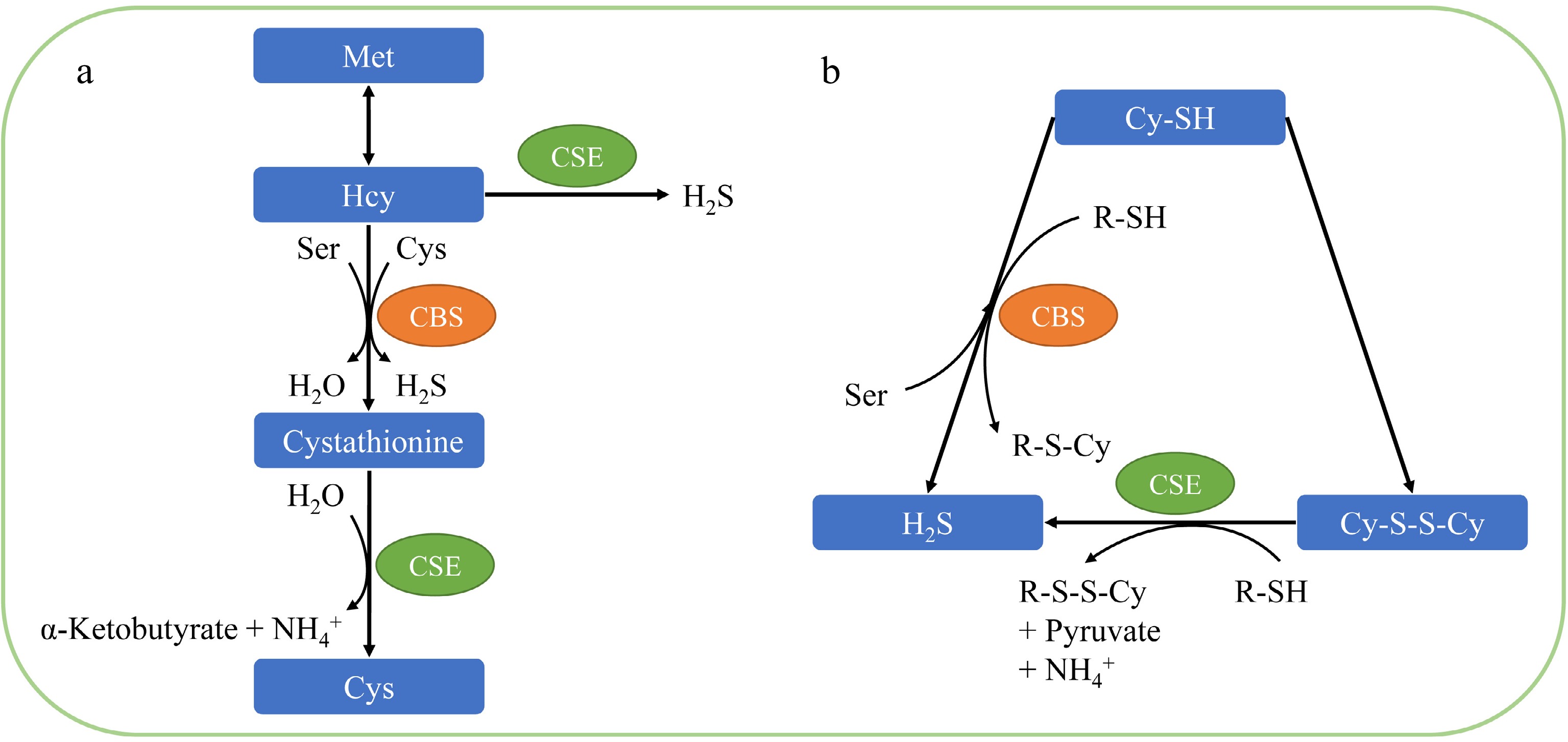-

Figure 1.
Endogenous H2S biosynthesis in higher plants. SO42−: sulfate ion; SO32−: sulfite ion; ATPs: ATP sulfurylase; APS: adenosine 50-phosphosulfate; APR: APS reductase; SiR: sulfite reductase; β-CAS: β-cyanoalanine synthase; L-Cys: L-cysteine; D-Cys: D-cysteine; L-DES: L-cysteine desulfhydrase; D-DES: D-cysteine desulfhydrase; DES1: L-cysteine desulfhydrase 1; Ser: serine; SAT: serine acetyltransferase; OAS: Oacetylserine; OAS-TL: O-acetylserine thiol lyase; GSH: reduced glutathione.
-

Figure 2.
Generation of H2S in mammals and yeast. (a) H2S is produced by sulfur metabolism, wherein CSE and CBS participate in each step. (b) Cys with thiols can be further interacted by CSE and CBS to synthesize H2S endogenously through triggering replacement reactions. Met, methionine; Hcy, homocysteine; CSE, cystathionine-γ-lyase; CBS, cystathionine-β-synthase; Ser, serine; Cys, cysteine; Cy-SH, cysteine; Cy-S-S-Cy, disulfide.
-

Figure 3.
Exogenous H2S regulates numerous physiological processes to improve postharvest quality of fruits and vegetables. (a) A simple model showing a cascade of events after exogenous H2S, which may stimulate various components of enzyme systems to maintain cellular homeostasis, but it is still not well understood how H2S works with other molecules like ABA, NO, Ca2+ and ROS, etc. Broken red arrows represent processes triggered by H2S, and broken blue arrows indicate abiotic stress-induced. (b) Various functions of H2S in metabolic enzyme systems. (b-i) H2S regulates related genes to delay senescence, especially ethylene (ET) biosynthesis and signaling transduction. (b-ii) The roles of H2S in the antioxidant system, which is essential for H2S-derived beneficial effects. (b-iii) H2S sustains the integrity of cell membrane. (b-iv) H2S facilitates ATP supply. (b-v) Inhibitory effect of H2S on cell wall loosening. (b-vi) H2S shows different mechanisms of redox homeostasis in hosts and fungi. Red arrows indicate that exogenous H2S enhanced the enzyme activity. The orange font implies that different results are obtained after H2S treatment, which correlates with whether the analyses are performed under cellular/subcellular or cell-free conditions (purified proteins)[81].
-
Materials Treatment Effect Reference Vegetables Pak choy (Shanghai) Green curly kale (Sabellica) Sweet Italian basil (Ocimum basilicum) NaHS fumigation for 4 h (0, 50,
100 and 250 μL L−1 H2S)Decreased ethylene production, chlorophyll loss and respiration rate [26] Non-climacteric fruit Strawberry (Fengxiang) 0.8 mM NaHS and 5 μM SNP immersion for 10 min Inhibited respiration rate and maintained crust color [33] Climacteric fruit Peach (Dahong) 15 μL L−1 NO gas and 20 μL L−1
H2S gas fumigation for 20 minReduced ACS and ACO activities and inhibited respiration rate [34] Kiwifruit (Qinmei) 1.0 mM NaHS fumigation for 8 d Down-regulated the expression of ethylene synthesis-related genes like AdSAM, AdACS1, AdACS2, AdACO2 and AdACO3 [28] Kiwifruit (Jinkui) 20 μL L−1 H2S gas fumigation for 0.5 h Down-regulated the expression of ethylene receptor 2 (ETR2), ERF003, ERF5 and ERF016; up-regulated the expression of ERF4 and ERF113 [32] Fresh-cut apple (Fuji) 0.4 mM NaHS fumigation for 5 d Up-regulated MdDHAR expression and down-regulated the expression of MdLOX2, MdPG1, MdPPO, MdACO1, MdERS1 and MdETR1 [29] Banana (Brazil) 1.0 mM NaHS and 1.0 g L−1 ethephon solution fumigation
for 6 dInhibited chlorophyll loss; up-regulated the expression of ethylene receptor genes MaETR, MaERS1 and MaERS2; down-regulated the expression of ethylene synthesis-related genes like MaACS1, MaACS2 and MaACO1 [30] Tomato (Micro Tom) 0.9 mM NaHS and 1.0 g L−1 ethephon solution fumigation
for 24 hMaintained better appearance and postharvest quality and down-regulated the expression of ERF003 and DOF22 [37] Table 1.
H2S counteracts the effects of ethylene in postharvest fruits and vegetables.
-
Materials Treatment Results Reference Delay ripening and senescence Tomato (Micro Tom) 0.9 mM NaHS and 1.0 g L−1 ethephon fumigation for 24 h Enhanced CAT, POD, APX, SOD and PAL activities; reduced LOX and PPO activities; inhibited H2O2, O2−· and MDA accumulation [27] Fresh-cut pear (Dangshan) 2.0 mM NaHS fumigation for 6 d Enhanced CAT, APX and POD activities; reduced PAL, PPO and LOX activities; reduced H2O2, O2−· and MDA content [38] Water spinach (Ipomoea aquatica) 2.4 mM NaHS fumigation for 8 d Enhanced CAT, POD and SOD activities, as well as higher DPPH scavenging activity; reduced O2−· and MDA content; increased endogenous H2S content by higher LCD and DCD activities [41] Grape (Kyoho) 1.0 mM NaHS fumigation for 7 d Enhanced CAT and APX activities; reduced LOX activities; reduced H2O2, O2−· and MDA content [47] Apple (Red Fuji) 0.7 mM NaHS fumigation for 24 h Enhanced CAT, SOD, PAL and GR activities; increased antioxidants content like AsA and phenolic; reduced PPO, POD and APX activities, as well as H2O2 accumulation [48] Mulberry (Dianmian-1) 0.8 mM NaHS fumigation for 6 d Enhanced DPPH and O2−· scavenging activity by higher CAT, POD and SOD activities; reduced O2−· and MDA content; increased endogenous H2S levels by higher LCD and DCD activities [52] Fresh-cut lotus roots
(Taikong Lian III)15 μL L−1 H2S gas fumigation for
30 minEnhanced total phenols and antioxidant capacity; higher PAL and CAT activities; lower PPO and POD activities; reduced H2O2 and O2−· production [54] Alleviate chilling injury Banana (Brazil) 0.5 mM NaHS fumigation for 24 h Enhanced CAT, POD, APX, SOD and GR activities; reduced H2O2, O2−· and MDA content; alleviated electrolyte leakage and CI [49] Hawthorn (Crataegus monogyna) 1.5 mM NaHS fumigation for 48 h Alleviated CI; enhanced CAT, APX, SOD and PAL activities; reduced H2O2 and MDA content; enhanced LCD and DCD activities, while increased endogenous H2S levels [50] Kiwifruit (Jinkui) 45 μM H2S immersion for 30 min Enhanced CAT, POD and SOD activities; reduced H2O2 and O2−· content; inhibited electrolyte leakage [51] Table 2.
Effects of H2S on antioxidant system in postharvest.
-
Materials Pathogens Treatment Effect Reference Pear (Dangshan) Aspergillus niger Penicillium expansum NaHS fumigation for 6 d (2.0 mM) Enhanced antioxidant capacity of fresh-cut pear and inhibited ROS accumulation; increased POD activity; reduced PAL and PPO activities; inhibited mycelium growth and lesion diameter on pears [38] Fresh-cut sweet potato (Xushu 18) Mucor rouxianus Rhizopus nigricans Geotrichum candidum NaHS fumigation for 4 d (2.0 mM) decreased PPO and LOX activities; lower POD activity; inhibited fugal growth and its pathogenicity [63] Apple (Malus domestica), mandarin (Citrus reticulata), sweet orange (Citrus sinensis), kiwifruits (Actinidia deliciosa), pear (Pyrus bretschneideri Rehd), tomato (Lycopersicon esculentum) Aspergillus niger Penicillium italicum NaHS fumigation for 9 d (0.5 mM) Inhibited spore germination, germ tube elongation, mycelial growth; promoted ROS accumulation by reducing SOD and CAT activities in A. niger, as well as higher expression of SOD and CAT [64] Chinese white pear (Pyrus bretschneideri) Aspergillus niger Deletion of the cbsA Gene in A. niger niger MA: induced higher resistance to cadmium stress and stronger infectivity to pears; increased Cys and GSH levels; decreased endogenous H2S content [67] infection with above mutant Pear fruit: increased the accumulation of H2O2, O2−· and MDA; induced larger lesion diameter Peach (Mengyin) Monilinia fructicola NaHS fumigation for 2 h (50 mM) M. fructicola: inhibited spore germination, mycelial growth and pathogenicity Peach fruit: enhanced CHT, GLU and PAL activities, while up-regulated the expression of related genes; reduced disease incidence and lesion diameter [70] Table 3.
Effects of H2S on disease resistance in postharvest fruits and vegetables.
Figures
(3)
Tables
(3)